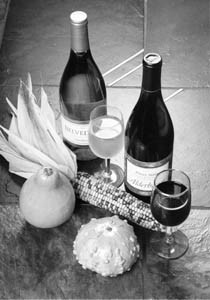What a Turkey!
The annual vino conundrum of the Thanksgiving holiday feast
By Bob Johnson
COLUMBUS discovered America, Nixon was not a crook, and Clinton did not have sexual relations with “that woman.” Myths abound in American history, and they are perpetuated early in our lower institutes of learning. What grade school kid hasn’t been exposed to the image of Pilgrim settlers and Native Americans sitting down to a bountiful and harmonious feast billed as “the first Thanksgiving dinner”?
If you find it difficult to picture 17th-century Native Americans welcoming newcomers to their shores with open arms, you’re not alone. Well-documented accounts indicate that initial encounters between the two groups were far from friendly, and the Western range wars that would follow decades hence weren’t exactly symbols of a successful melting pot.
Still, the “first Thanksgiving” image lingered, and as the 20th century dawned, it was perpetuated through patriotic murals in town squares, calendar drawings, and illustrations in Saturday Evening Postesque publications.
In 1920, when the 300th anniversary of the Pilgrims’ alleged philanthropy was celebrated, their place in history–erroneously depicted as it may have been–became permanently etched in the American psyche . . . and in the schoolbooks of America’s children.
While “the first Thanksgiving” may be a myth, the occurrence of harvest celebrations in colonial New England was not at all unusual. Sourcing an array of historical documents and family letters, a Massachusetts restaurant once attempted to replicate a “typical” harvest feast and included unnamed “wine, beer and cider” on the bill of fare.
Among the delicacies it concocted were bread of Indian corn, seethed fish, roast fowl (goose, swan, or turkey) with sauce, boiled sallet, dish of Jerusalem artichokes, boiled onions, furmenty, and, for dessert, a prune tart.
In other words, in at least one way, it was much like a modern Thanksgiving feast: it was a wine-matching nightmare.
The most talented vintner in the world, working with the most expressive clonal selections grown in the most ideally situated and meticulously tended vineyard, would not be able to craft a wine, be it purely varietal or a blend, that would match both seethed fish and a prune tart. Ain’t gonna happen.
However, clever Thanksgiving hosts have learned how to deal with the annual vino conundrum of the holiday feast. Rather than seeking that one unattainable bottle that would go sublimely with every dish–be it Jerusalem artichokes or green beans, furmenty or candied yams–they extend the bountiful theme to the beverage tray as well.
And rather than sticking to “safe” staples such as chardonnay or pinot noir, they push the culinary envelope by uncorking lesser-known and underappreciated varietals.
Fortunately, there is no shortage of such bottlings in the Y2K wine marketplace, especially for those who live so close to the source: the region generically referred to as “North Coast Wine Country.”
By uncorking these five bottles on the fourth Thursday of this month, one can accommodate virtually every flavor-matching challenge that the typical holiday feast–circa the 17th century or the 21st–could present.
Windsor Vineyards 1999 Private Reserve Semillon, Mendocino County ($15). Barely a semillon by definition, this blend also includes generous dollops of muscat canelli, sauvignon blanc, and chardonnay. With so many ingredients, its complexity is no surprise; vanilla, pear, smoky oak, and various baking spices jump out of the glass and linger in the after-flavor. This is a wine that will engage those who don’t normally drink vino, and at the same time won’t disappoint the chardonnay groupies. Rating: 3.5 corks (out of 4).
Shenandoah Vineyards 1998 Barbera, Amador County ($14.95). This “Cal-Ital” bottling is fruity from start to finish, with a distinct berry character and hints of coffee beans and coconut. A wine that should keep the pinot-philes satisfied. Rating: 3 corks.
Haywood Estate 1997 Zinfandel, Los Chamizal Vineyard, Sonoma Valley ($25). Some zins are big, some are enormous, and some are elegant. This one falls in the last category, with a subtle pepper aroma leading to flavors of blackberry jam, cedar, and cherry. Because it defies the in-your-face style of bigger zins, this is an extremely versatile food wine –ideal for the holiday table. Rating: 4 corks.
Fife 1998 “Redhead” Carignane, Redwood Valley ($18.50). The perfect companion to game meats or fowl, this smooth yet powerful wine is not at all subtle. Its aroma and flavor spectrum includes leather, white pepper, and various fruit flavors (plum, cherry, citrus), and its deep purple color is stunning against the backdrop of a white tablecloth. A wine that tastes good and looks good. Rating: 3.5 corks.
Husch Vineyards 1998 Postre, Mendocino ($20 per 375-ml. bottle). En español, postre means dessert, and this late-harvest sauvignon blanc would be a wonderful way to wrap up the Thanksgiving feast–with pumpkin or mincemeat pie, or solo. Nearly as much fun to smell as it is to drink, it conjures violets, orange peel, exotic spices, and even bananas Foster. Rating: 3.5 corks.
When historians summarize the wines available for Thanksgiving meals in the year 2000, they’ll likely do so with heaping helpings of praise.
And that assessment will be no myth.
From the November 2-8, 2000 issue of the Northern California Bohemian.











